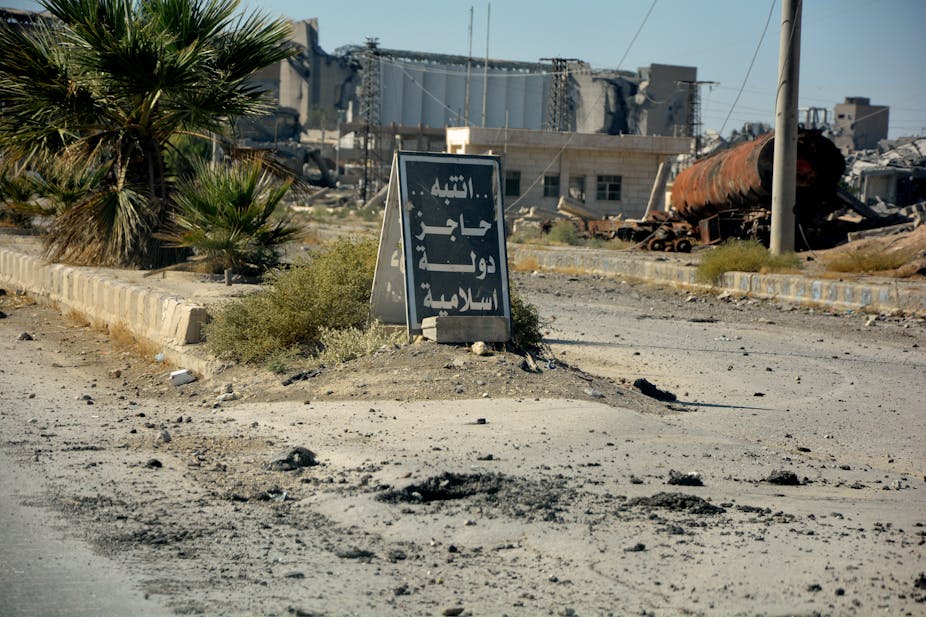The international military coalition fighting against so-called Islamic State (IS) achieved a notable victory in October by retaking the Syrian city of Raqqa, the “capital” of IS’s self-declared caliphate in parts of Iraq and Syria. As the size of the territory held by IS continues to shrink, there are growing concerns about the number of foreign fighters returning to Europe and what to do about them.
Since 2014, when IS declared its new caliphate, thousands of foreign fighters from across the world have travelled to join its fight. In July 2017, the government estimated that 850 British nationals had travelled to fight in Syria or Iraq and that around half had returned – although not all of these were affiliated with IS.
These returning foreign terrorist fighters present a considerable challenge for the authorities. Returnees fall into different categories, each presenting a different level of risk. For example, those only in IS-controlled territory for a short while are different from those fully committed to the IS cause who are sent abroad by IS.
There are a variety of measures that could be deployed in response, including some form of amnesty or possibly a programme of reintegration – an approach used in Denmark. But the most likely course of action is criminal prosecution.
Format of the prosecution
Before any prosecution is launched, the prosecutor must be satisfied that there is sufficient evidence to provide a realistic prospect of conviction. Then, the prosecutor must be satisfied that a prosecution is required in the public interest. These decisions can be difficult to make. In addition to these tests, for any prosecution of returning foreign terrorist fighters the permission of the attorney general is required.
IS is a proscribed terrorist organisation in the UK, based on the definition of “terrorism” set out in the Terrorism Act 2000.
But when it comes to prosecuting foreign fighters, prosecutors will turn to the Terrorism Act 2006, in particular Section 2 and Section 5. Prosecutions under this act are also used in relation to people who travelled to Iraq or Syria and who fought against IS.
Section 5 relates to “preparation of terrorist acts” and makes it an offence for a person to engage in the preparation of acts of terrorism, or to assist others in their preparation. The prosecution must prove that the person had a specific intent to commit an act or acts of terrorism, but the offence can encompass a wide range of different levels of criminality.
The Serious Crime Act 2015 provided for what’s called “extra-territorial jurisdiction” for offences under Section 5. Before this amendment to the law, efforts to secure a conviction had to be based solely on plans made prior to the person’s departure from the UK. Now it is possible to use any relevant activity undertaken abroad in evidence, for example there might be testimony from people the accused encountered in Syria.
The case of Mohammed Uddin is an example of a successful prosecution under Section 5. He was stopped in 2014 when he left Syria and crossed the border back into Turkey. Clothing found in his rucksack consisted mainly of outdoor active wear which resembled that worn by professional security services. Conversations found within the social media applications on his media devices provided evidence of his intention to engage in combat. In 2016, he was sentenced to seven years’ imprisonment.
Section 2 relates to “dissemination of terrorist publications” and makes it an offence to distribute a terrorist publication with the intention of encouraging acts of terrorism. Under the act, a terrorist publication is one which could be deemed useful to a person in the commission or preparation of acts of terror.
Ednane Mahmood – who left Britain with the intention of reaching Syria but never made it – was convicted of this offence in 2015 after examination of his electronic devices revealed IS propaganda material that amounted to sufficient evidence.

Available sentences
In September 2017, Max Hill, the independent reviewer of terrorism legislation, described Sections 2 and 5 of the 2006 act as the “charges of choice for prosecutors which gain far more use than others”.
The maximum sentence for offences under Section 5 is life imprisonment, and seven years for offences under Section 2. In 2016, the Court of Appeal set out factors that would affect likely sentencing in a Section 5 case. These are the culpability of the offender – mainly in terms of the closeness to carrying out any intended act – and the harm which might have been caused if the act had been successful.
At the moment there is limited guidance for courts on the sentencing of this and other terrorism offences. The Sentencing Council recently launched a consultation on its proposed guidelines on sentencing terrorism offences, with the aim of assisting judges to reach appropriate and consistent sentences.

